Changyuan Zhao
Energy Efficient Trajectory Control and Resource Allocation in Multi-UAV-assisted MEC via Deep Reinforcement Learning
Aug 01, 2025Abstract:Mobile edge computing (MEC) is a promising technique to improve the computational capacity of smart devices (SDs) in Internet of Things (IoT). However, the performance of MEC is restricted due to its fixed location and limited service scope. Hence, we investigate an unmanned aerial vehicle (UAV)-assisted MEC system, where multiple UAVs are dispatched and each UAV can simultaneously provide computing service for multiple SDs. To improve the performance of system, we formulated a UAV-based trajectory control and resource allocation multi-objective optimization problem (TCRAMOP) to simultaneously maximize the offloading number of UAVs and minimize total offloading delay and total energy consumption of UAVs by optimizing the flight paths of UAVs as well as the computing resource allocated to served SDs. Then, consider that the solution of TCRAMOP requires continuous decision-making and the system is dynamic, we propose an enhanced deep reinforcement learning (DRL) algorithm, namely, distributed proximal policy optimization with imitation learning (DPPOIL). This algorithm incorporates the generative adversarial imitation learning technique to improve the policy performance. Simulation results demonstrate the effectiveness of our proposed DPPOIL and prove that the learned strategy of DPPOIL is better compared with other baseline methods.
Temporal Spectrum Cartography in Low-Altitude Economy Networks: A Generative AI Framework with Multi-Agent Learning
May 21, 2025Abstract:This paper introduces a two-stage generative AI (GenAI) framework tailored for temporal spectrum cartography in low-altitude economy networks (LAENets). LAENets, characterized by diverse aerial devices such as UAVs, rely heavily on wireless communication technologies while facing challenges, including spectrum congestion and dynamic environmental interference. Traditional spectrum cartography methods have limitations in handling the temporal and spatial complexities inherent to these networks. Addressing these challenges, the proposed framework first employs a Reconstructive Masked Autoencoder (RecMAE) capable of accurately reconstructing spectrum maps from sparse and temporally varying sensor data using a novel dual-mask mechanism. This approach significantly enhances the precision of reconstructed radio frequency (RF) power maps. In the second stage, the Multi-agent Diffusion Policy (MADP) method integrates diffusion-based reinforcement learning to optimize the trajectories of dynamic UAV sensors. By leveraging temporal-attention encoding, this method effectively manages spatial exploration and exploitation to minimize cumulative reconstruction errors. Extensive numerical experiments validate that this integrated GenAI framework outperforms traditional interpolation methods and deep learning baselines by achieving 57.35% and 88.68% reconstruction error reduction, respectively. The proposed trajectory planner substantially improves spectrum map accuracy, reconstruction stability, and sensor deployment efficiency in dynamically evolving low-altitude environments.
Decentralization of Generative AI via Mixture of Experts for Wireless Networks: A Comprehensive Survey
Apr 28, 2025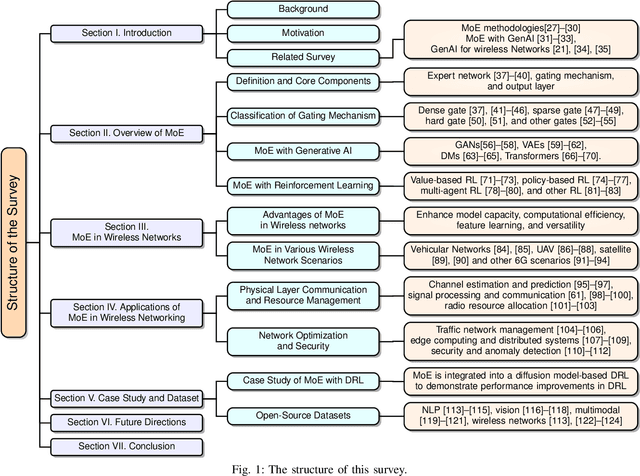
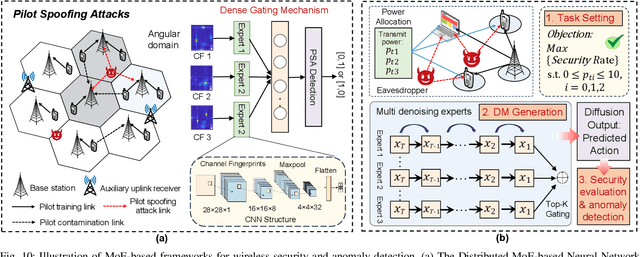
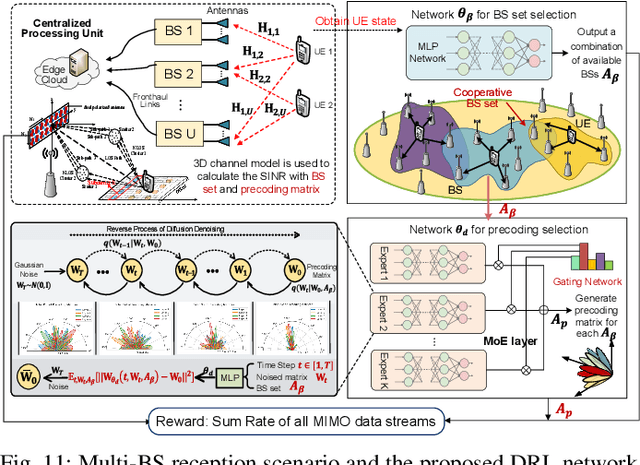
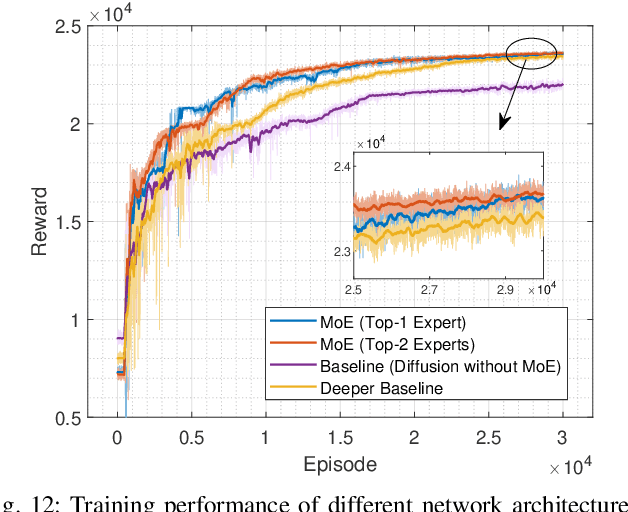
Abstract:Mixture of Experts (MoE) has emerged as a promising paradigm for scaling model capacity while preserving computational efficiency, particularly in large-scale machine learning architectures such as large language models (LLMs). Recent advances in MoE have facilitated its adoption in wireless networks to address the increasing complexity and heterogeneity of modern communication systems. This paper presents a comprehensive survey of the MoE framework in wireless networks, highlighting its potential in optimizing resource efficiency, improving scalability, and enhancing adaptability across diverse network tasks. We first introduce the fundamental concepts of MoE, including various gating mechanisms and the integration with generative AI (GenAI) and reinforcement learning (RL). Subsequently, we discuss the extensive applications of MoE across critical wireless communication scenarios, such as vehicular networks, unmanned aerial vehicles (UAVs), satellite communications, heterogeneous networks, integrated sensing and communication (ISAC), and mobile edge networks. Furthermore, key applications in channel prediction, physical layer signal processing, radio resource management, network optimization, and security are thoroughly examined. Additionally, we present a detailed overview of open-source datasets that are widely used in MoE-based models to support diverse machine learning tasks. Finally, this survey identifies crucial future research directions for MoE, emphasizing the importance of advanced training techniques, resource-aware gating strategies, and deeper integration with emerging 6G technologies.
Generative AI-enabled Wireless Communications for Robust Low-Altitude Economy Networking
Feb 25, 2025Abstract:Low-Altitude Economy Networks (LAENets) have emerged as significant enablers of social activities, offering low-altitude services such as the transportation of packages, groceries, and medical supplies. Unlike traditional terrestrial networks, LAENets are characterized by control mechanisms and ever-changing operational factors, which make them more complex and susceptible to vulnerabilities. As applications of LAENet continue to expand, robustness of these systems becomes crucial. In this paper, we investigate a novel application of Generative Artificial Intelligence (GenAI) to improve the robustness of LAENets. We conduct a systematic analysis of robustness requirements for LAENets, complemented by a comprehensive review of robust Quality of Service (QoS) metrics from the wireless physical layer perspective. We then investigate existing GenAI-enabled approaches for robustness enhancement. This leads to our proposal of a novel diffusion-based optimization framework with a Mixture of Expert (MoE)-transformer actor network. In the robust beamforming case study, the proposed framework demonstrates its effectiveness by optimizing beamforming under uncertainties, achieving a more than 44% increase in the worst-case achievable secrecy rate. These findings highlight the significant potential of GenAI in strengthening LAENet robustness.
Generative AI Enabled Robust Data Augmentation for Wireless Sensing in ISAC Networks
Feb 18, 2025Abstract:Integrated sensing and communication (ISAC) uses the same software and hardware resources to achieve both communication and sensing functionalities. Thus, it stands as one of the core technologies of 6G and has garnered significant attention in recent years. In ISAC systems, a variety of machine learning models are trained to analyze and identify signal patterns, thereby ensuring reliable sensing and communications. However, considering factors such as communication rates, costs, and privacy, collecting sufficient training data from various ISAC scenarios for these models is impractical. Hence, this paper introduces a generative AI (GenAI) enabled robust data augmentation scheme. The scheme first employs a conditioned diffusion model trained on a limited amount of collected CSI data to generate new samples, thereby expanding the sample quantity. Building on this, the scheme further utilizes another diffusion model to enhance the sample quality, thereby facilitating the data augmentation in scenarios where the original sensing data is insufficient and unevenly distributed. Moreover, we propose a novel algorithm to estimate the acceleration and jerk of signal propagation path length changes from CSI. We then use the proposed scheme to enhance the estimated parameters and detect the number of targets based on the enhanced data. The evaluation reveals that our scheme improves the detection performance by up to 70%, demonstrating reliability and robustness, which supports the deployment and practical use of the ISAC network.
Supervised Score-Based Modeling by Gradient Boosting
Nov 02, 2024Abstract:Score-based generative models can effectively learn the distribution of data by estimating the gradient of the distribution. Due to the multi-step denoising characteristic, researchers have recently considered combining score-based generative models with the gradient boosting algorithm, a multi-step supervised learning algorithm, to solve supervised learning tasks. However, existing generative model algorithms are often limited by the stochastic nature of the models and the long inference time, impacting prediction performances. Therefore, we propose a Supervised Score-based Model (SSM), which can be viewed as a gradient boosting algorithm combining score matching. We provide a theoretical analysis of learning and sampling for SSM to balance inference time and prediction accuracy. Via the ablation experiment in selected examples, we demonstrate the outstanding performances of the proposed techniques. Additionally, we compare our model with other probabilistic models, including Natural Gradient Boosting (NGboost), Classification and Regression Diffusion Models (CARD), Diffusion Boosted Trees (DBT), and Bayesian neural network-based models. The experimental results show that our model outperforms existing models in both accuracy and inference time.
Signal Detection in Near-field Communication with Unknown Noise Characteristics: A Diffusion Model Method
Sep 21, 2024Abstract:In this letter, we present a diffusion model method for signal detection in near-field communication with unknown noise characteristics. We consider an uplink transmission of a near-filed MIMO communication system consisting of multiple mobile terminals and one base station with multiple antennas. Then, we proposed a Maximum Likelihood Estimation Diffusion Detector (MLEDD) aiming at learning the distribution of unknown noise. To this end, we define an error function via Bayes' theorem to detect the source signal. Moreover, we present an implementation of the proposed framework. The performance of the proposed method in terms of bit error rate shows that it outperforms the MLE detector, Detection Network (DetNet), and Maximum Normalizing Flow Estimate method (MANFE) across different signal-to-noise ratios and noise distributions. Especially when the noise distribution is intractable, diffusion, as a state-of-the-art probability model, has the best distribution learning ability compared to other models. These results affirm that this framework can effectively detect signals in near-field scenarios.
Repairing Deep Neural Networks Based on Behavior Imitation
May 05, 2023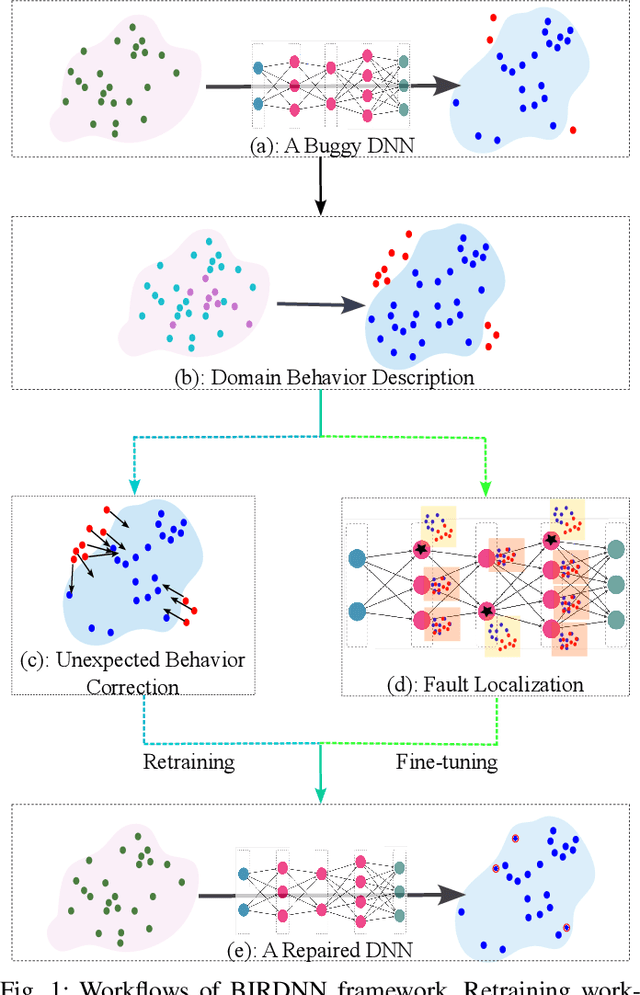
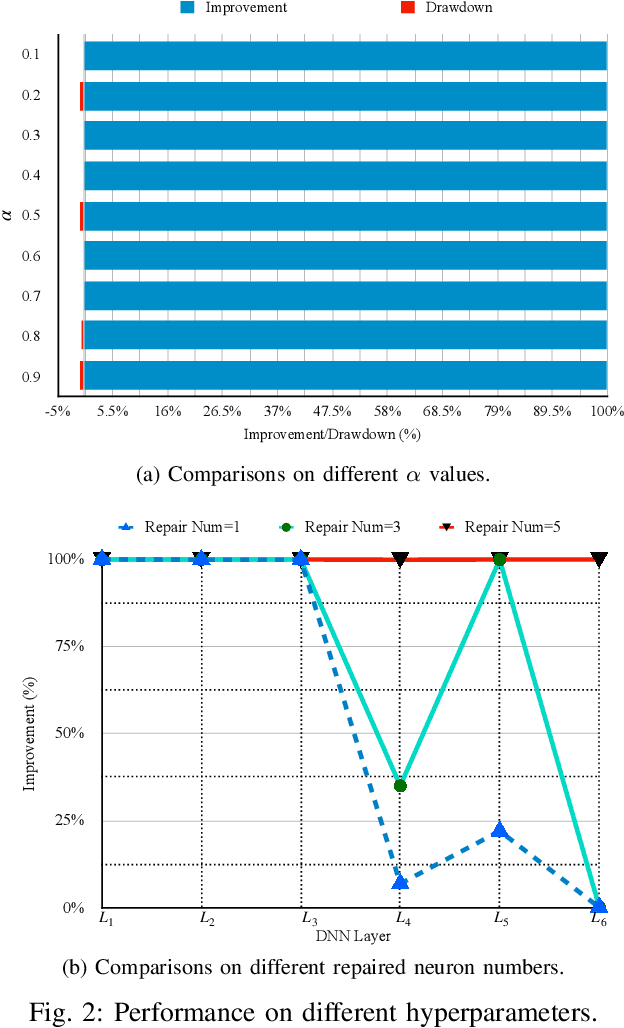
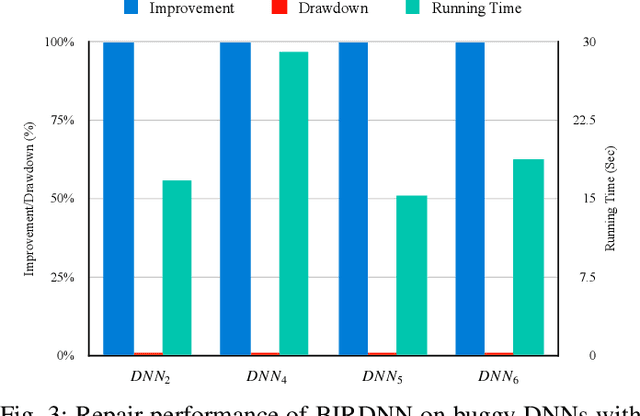

Abstract:The increasing use of deep neural networks (DNNs) in safety-critical systems has raised concerns about their potential for exhibiting ill-behaviors. While DNN verification and testing provide post hoc conclusions regarding unexpected behaviors, they do not prevent the erroneous behaviors from occurring. To address this issue, DNN repair/patch aims to eliminate unexpected predictions generated by defective DNNs. Two typical DNN repair paradigms are retraining and fine-tuning. However, existing methods focus on the high-level abstract interpretation or inference of state spaces, ignoring the underlying neurons' outputs. This renders patch processes computationally prohibitive and limited to piecewise linear (PWL) activation functions to great extent. To address these shortcomings, we propose a behavior-imitation based repair framework, BIRDNN, which integrates the two repair paradigms for the first time. BIRDNN corrects incorrect predictions of negative samples by imitating the closest expected behaviors of positive samples during the retraining repair procedure. For the fine-tuning repair process, BIRDNN analyzes the behavior differences of neurons on positive and negative samples to identify the most responsible neurons for the erroneous behaviors. To tackle more challenging domain-wise repair problems (DRPs), we synthesize BIRDNN with a domain behavior characterization technique to repair buggy DNNs in a probably approximated correct style. We also implement a prototype tool based on BIRDNN and evaluate it on ACAS Xu DNNs. Our experimental results show that BIRDNN can successfully repair buggy DNNs with significantly higher efficiency than state-of-the-art repair tools. Additionally, BIRDNN is highly compatible with different activation functions.
Credit Assignment for Trained Neural Networks Based on Koopman Operator Theory
Dec 02, 2022Abstract:Credit assignment problem of neural networks refers to evaluating the credit of each network component to the final outputs. For an untrained neural network, approaches to tackling it have made great contributions to parameter update and model revolution during the training phase. This problem on trained neural networks receives rare attention, nevertheless, it plays an increasingly important role in neural network patch, specification and verification. Based on Koopman operator theory, this paper presents an alternative perspective of linear dynamics on dealing with the credit assignment problem for trained neural networks. Regarding a neural network as the composition of sub-dynamics series, we utilize step-delay embedding to capture snapshots of each component, characterizing the established mapping as exactly as possible. To circumvent the dimension-difference problem encountered during the embedding, a composition and decomposition of an auxiliary linear layer, termed minimal linear dimension alignment, is carefully designed with rigorous formal guarantee. Afterwards, each component is approximated by a Koopman operator and we derive the Jacobian matrix and its corresponding determinant, similar to backward propagation. Then, we can define a metric with algebraic interpretability for the credit assignment of each network component. Moreover, experiments conducted on typical neural networks demonstrate the effectiveness of the proposed method.
 Add to Chrome
Add to Chrome Add to Firefox
Add to Firefox Add to Edge
Add to Edge